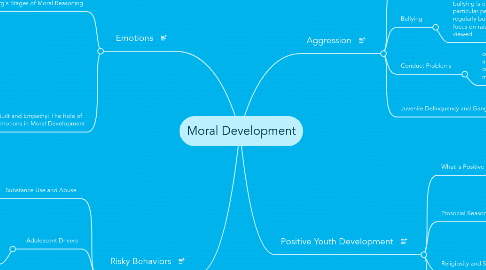
1. Emotions
1.1. Kohlberg's Stages of Moral Reasoning
1.1.1. Level 1: Preconventional
1.1.1.1. Stage 1: Punishment and Obedience Orientation
1.1.1.2. Stage 2: Individualism, instrumental purpose, and exchange
1.1.2. Level 2: Conventional
1.1.2.1. Stage 3: Mutual interpersonal expectations, relationships, and interpersonal conformity
1.1.2.2. Stage 4: social system and conscience
1.1.3. Level 3: Postconventional
1.1.3.1. Stage 5: Social contract or utility and individual rights
1.1.3.2. Stage 6: Universal ethical principals
1.2. Guilt and Empathy: The Role of Emotions in Moral Development
1.2.1. Frued, Guilt and Shame
1.2.1.1. Guilt is for a single occurrence and shame is an overall feeling of oneself. Reinforce positive behaviors instead of punishing negative behaviors
1.2.2. Empathy: Feeling Another's Pain
1.2.2.1. The difference between empathy and sympathy is that empathy is recognizing how they feel and sympathy is understanding how they feel.
2. Risky Behaviors
2.1. Substance Use and Abuse
2.1.1. Substance use is ingesting any legal or illegal substance on one or more occasion. Substance abuse is when the substance use affects the person's daily life. Substance abuse can include alcohol, tobacco, or many other drugs. Rates are increasing for substance abuse in teens, especially alcohol and tobacco.
2.2. Adolescent Drivers
2.2.1. The leading cause of death among adolescents is car accidents. Teens are involved in 12% of fatal crashes. GDL laws have been put into place that require teen drivers to be supervised while driving for the first 6-12 months of them having their license to reduce the frequency of fatal accidents.
2.3. Adolescent Sexual Activity
2.3.1. Sexual activity is increasing among teens, especially at younger ages. Research shows that kids with limited parental interaction and kids who live in poverty are also more likely to engage in sexual activity at younger ages. Although sexual education is growing in schools, this is not necessarily preventing teens from engaging in sexual activity at younger and younger ages.
2.4. Teen Pregnancy
2.4.1. Teen pregnancy is an increasing problem among adolescents. Teen pregnancy rates are increasing and there are many factors which contribute to this such as their home life, and substance use or abuse.
3. Aggression
3.1. Aggressive Behavior
3.1.1. aggression is any behavior that is intended to harm people or property. All children show aggression at times. It is important to discourage aggressive behaviors.
3.2. Bullying
3.2.1. bullying is ongoing verbal or physical aggression that is aimed at a particular person. About 10% of people report that they are regularly bullied. Anti-bullying programs can be successful if they focus on raising awareness of the changing ways bullying is being viewed.
3.3. Conduct Problems
3.3.1. conduct problems can be minor or sever. 2-9% of children have a conduct disorder. These children can be treated with counseling, behavioral therapy, family therapy and sometimes medication.
3.4. Juvenile Delinquency and Gangs
3.4.1. more common among boys, it usually occurs during adolescence. Peer pressure plays a big role in delinquency. This is a difficult subject with not clear and easy answers as to how to make it go away.
4. Positive Youth Development
4.1. What is Positive Youth Development?
4.1.1. positive youth development is the perspective that emphasizes how a child and their environment interact to produce positive developmental outcomes. The more developmental assets a child receives, the less likely they are to have risky behaviors
4.2. Prosocial Reasoning and Behavior
4.2.1. Prosocial reasoning is a persons thought process when they decide if they are going to help someone or not. Is a child willing to go out of their way to help another child even if it means that they are going to have to give a personal sacrifice, such as missing a party? Altruism is a voluntary behavior that is motivated by caring and being concerned about someone else.
4.3. Religiosity and Spirituality
4.3.1. religiosity is a persons relationship with their religion and how they view their religions beliefs. Spirituality is a persons sense of being connected to something greater than the self. Religious involvement are connected to a person having a better overall physical and mental health, less stress, and lower levels of risky behaviors.
4.4. How can adults help foster positive youth development?
4.4.1. Adults can encourage positive youth development by early caregiving, direct reinforcement, modeling, perspective taking, parental discipline practices, discussion of moral issues, parental and school expectations, fostering empathy and community features.
